Abstract
1. The purpose of this study was to elucidate the cellular mechanism of the positive inotropic effect of hydralazine, a vasodilator widely used for afterload reduction in patients with heart failure that has also been reported to have positive inotropic effects on the heart. After isolation, right ventricular papillary muscles from the ferret were maintained in bicarbonate-buffered salt solution (30 degrees C). A concentration-response relationship was obtained for hydralazine (10(-6) to 10(-3) M). In order to mimic different levels of catecholamine release found in heart failure, we utilized two methods of stimulation: (a) threshold punctate pulses and (b) suprathreshold punctate stimulation with voltage approximately 10% above threshold. 2. In a first group of muscles (n = 16), a maximally effective concentration of hydralazine (10(-3) M) increased peak isometric tension by 39 +/- 9% (P < 0.05). Doses lower than 10(-5) M had no significant effect. The bioluminescent Ca2+ indicator, aequorin, was loaded into a subset of these muscles (n = 7). A significant increase in peak light (i.e., intracellular Ca2+) developed, concurrently with an increase in peak tension (38 +/- 5% to 66 +/- 8%). This inotropic response was associated with a decrease in time to peak tension (ms), 221 +/- 7 to 186 +/- 5 (P < 0.05), and time to peak light, 65 +/- 4 to 52 +/- 2 (P < 0.05). These effects were markedly attenuated by pretreatment with autonomic blocking agents. 3. In a second group of muscles (n = 12), histamine was used to stimulate cyclic AMP production in the presence of propranolol.(ABSTRACT TRUNCATED AT 250 WORDS)
Full text
PDF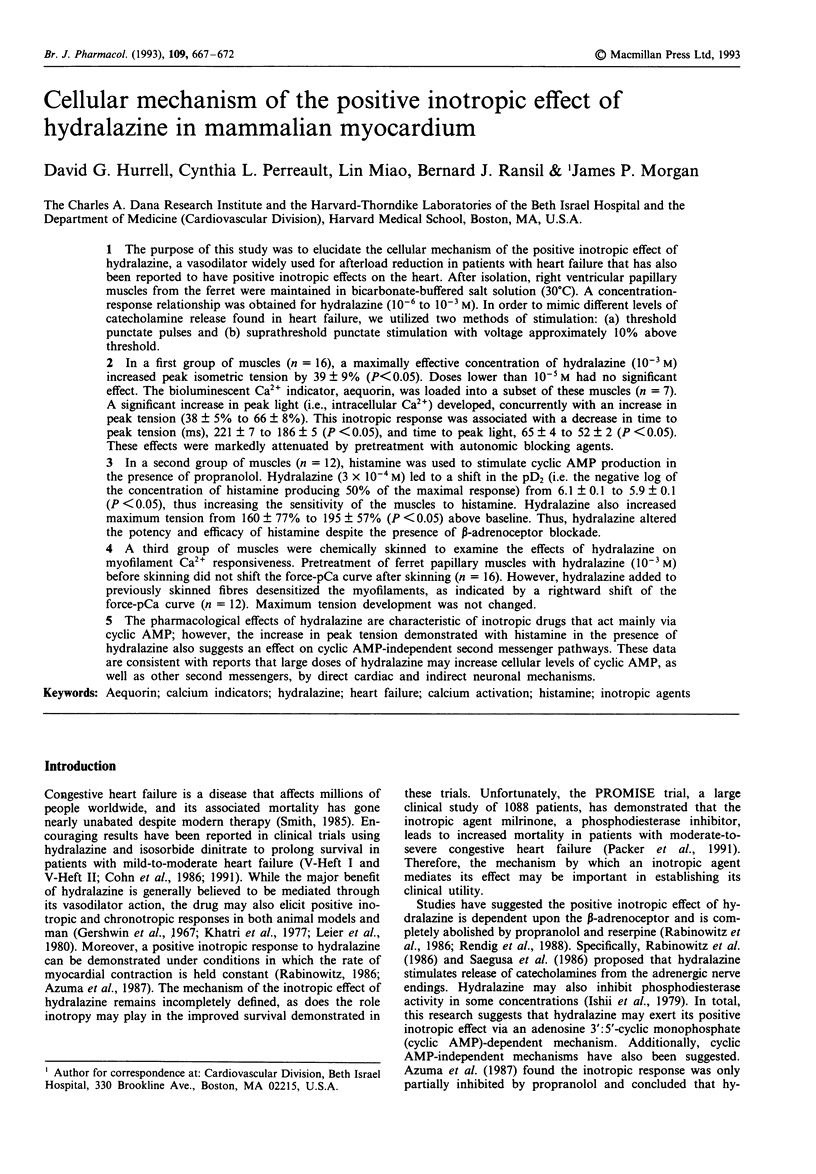
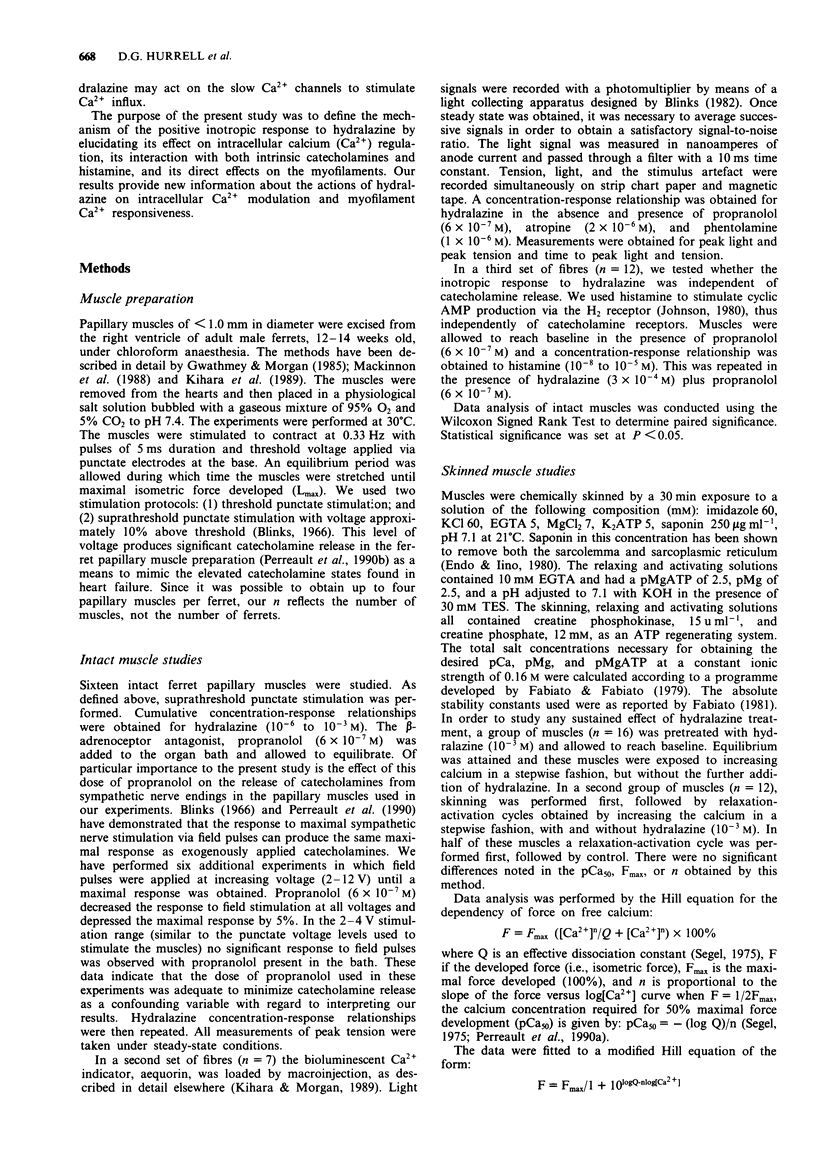
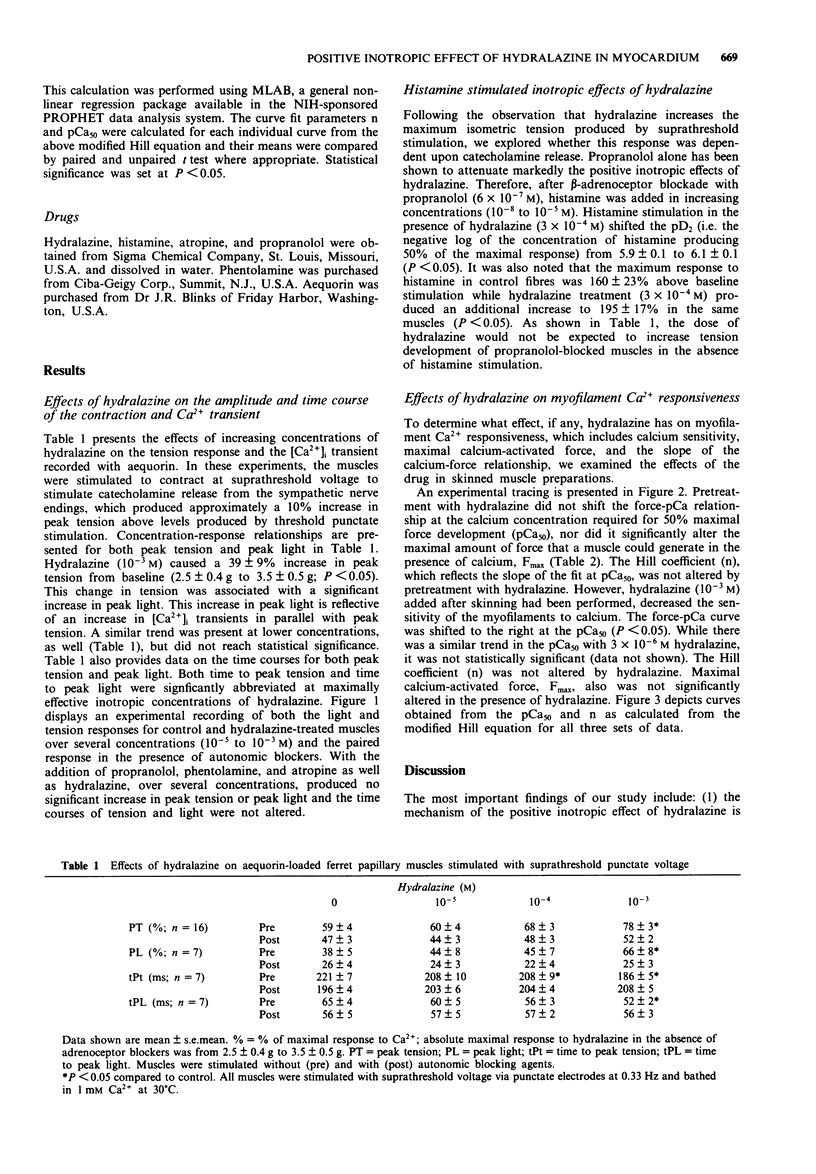
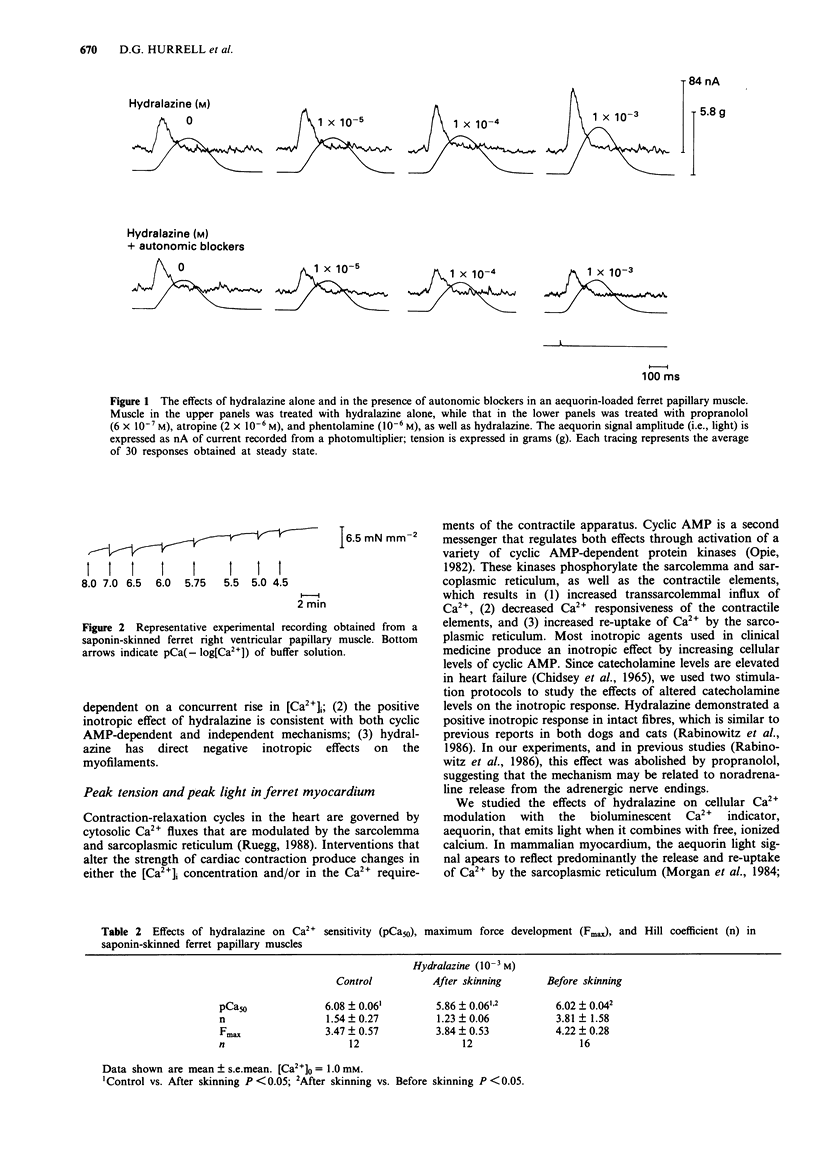
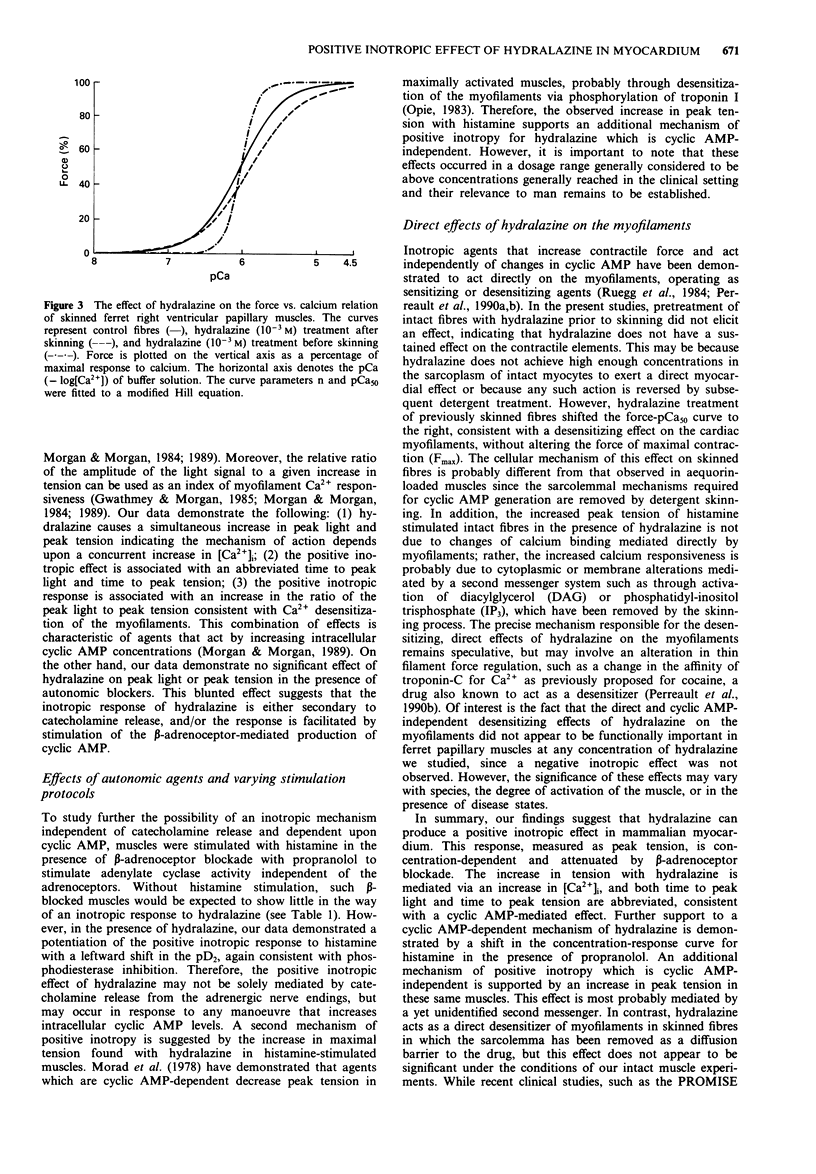
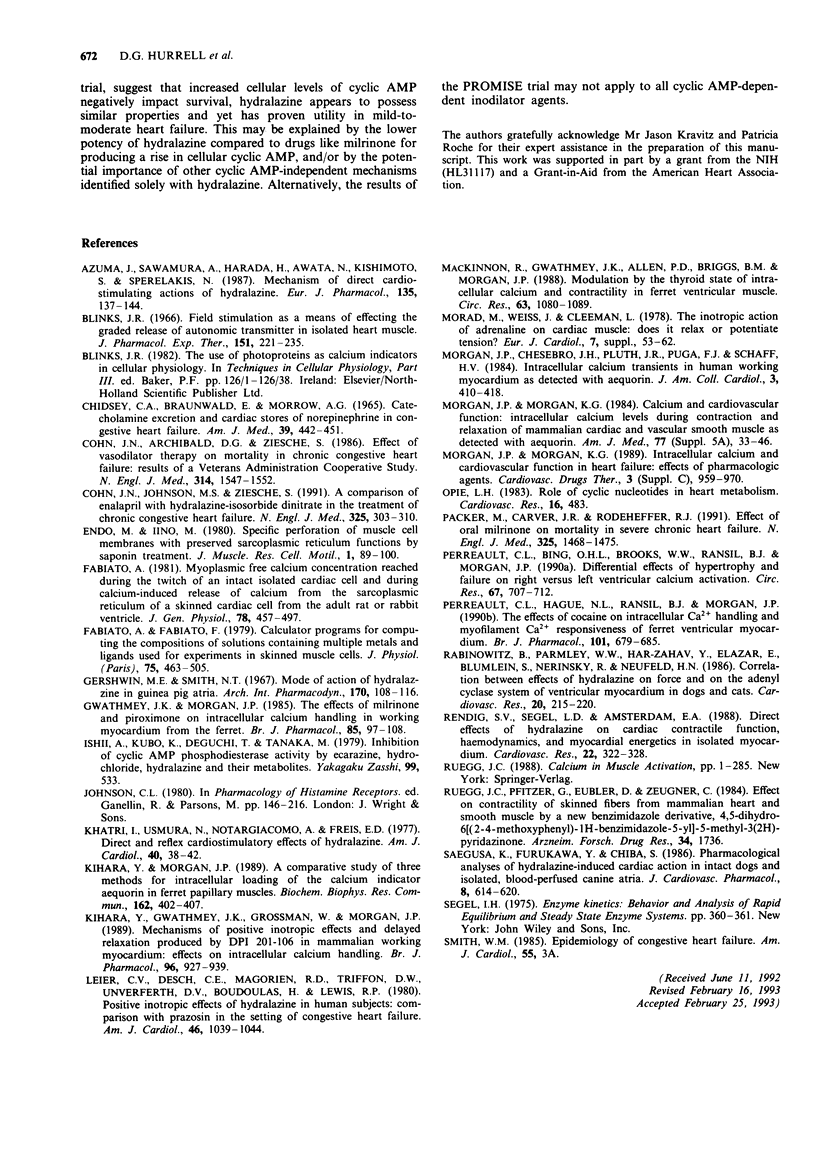
Selected References
These references are in PubMed. This may not be the complete list of references from this article.
- Azuma J., Sawamura A., Harada H., Awata N., Kishimoto S., Sperelakis N. Mechanism of direct cardiostimulating actions of hydralazine. Eur J Pharmacol. 1987 Mar 17;135(2):137–144. doi: 10.1016/0014-2999(87)90605-4. [DOI] [PubMed] [Google Scholar]
- Blinks J. R. Field stimulation as a means of effecting the graded release of autonomic transmitters in isolated heart muscle. J Pharmacol Exp Ther. 1966 Feb;151(2):221–235. [PubMed] [Google Scholar]
- CHIDSEY C. A., BRAUNWALD E., MORROW A. G. CATECHOLAMINE EXCRETION AND CARDIAC STORES OF NOREPINEPHRINE IN CONGESTIVE HEART FAILURE. Am J Med. 1965 Sep;39:442–451. doi: 10.1016/0002-9343(65)90211-1. [DOI] [PubMed] [Google Scholar]
- Cohn J. N., Archibald D. G., Ziesche S., Franciosa J. A., Harston W. E., Tristani F. E., Dunkman W. B., Jacobs W., Francis G. S., Flohr K. H. Effect of vasodilator therapy on mortality in chronic congestive heart failure. Results of a Veterans Administration Cooperative Study. N Engl J Med. 1986 Jun 12;314(24):1547–1552. doi: 10.1056/NEJM198606123142404. [DOI] [PubMed] [Google Scholar]
- Cohn J. N., Johnson G., Ziesche S., Cobb F., Francis G., Tristani F., Smith R., Dunkman W. B., Loeb H., Wong M. A comparison of enalapril with hydralazine-isosorbide dinitrate in the treatment of chronic congestive heart failure. N Engl J Med. 1991 Aug 1;325(5):303–310. doi: 10.1056/NEJM199108013250502. [DOI] [PubMed] [Google Scholar]
- Endo M., Iino M. Specific perforation of muscle cell membranes with preserved SR functions by saponin treatment. J Muscle Res Cell Motil. 1980 Mar;1(1):89–100. doi: 10.1007/BF00711927. [DOI] [PubMed] [Google Scholar]
- Fabiato A., Fabiato F. Calculator programs for computing the composition of the solutions containing multiple metals and ligands used for experiments in skinned muscle cells. J Physiol (Paris) 1979;75(5):463–505. [PubMed] [Google Scholar]
- Fabiato A. Myoplasmic free calcium concentration reached during the twitch of an intact isolated cardiac cell and during calcium-induced release of calcium from the sarcoplasmic reticulum of a skinned cardiac cell from the adult rat or rabbit ventricle. J Gen Physiol. 1981 Nov;78(5):457–497. doi: 10.1085/jgp.78.5.457. [DOI] [PMC free article] [PubMed] [Google Scholar]
- Gershwin M. E., Smith N. T. Mode of action of hydralazine on guinea pig atria. Arch Int Pharmacodyn Ther. 1967 Nov;170(1):108–116. [PubMed] [Google Scholar]
- Gwathmey J. K., Morgan J. P. The effects of milrinone and piroximone on intracellular calcium handling in working myocardium from the ferret. Br J Pharmacol. 1985 May;85(1):97–108. doi: 10.1111/j.1476-5381.1985.tb08835.x. [DOI] [PMC free article] [PubMed] [Google Scholar]
- Ishii A., Kubo K., Deguchi T., Tanaka M. [Inhibition of cyclic AMP phosphodiesterase activity by ecarazine hydrochloride, hydralazine and their metabolites (author's transl)]. Yakugaku Zasshi. 1979 May;99(5):533–536. doi: 10.1248/yakushi1947.99.5_533. [DOI] [PubMed] [Google Scholar]
- Khatri I., Uemura N., Notargiacomo A., Freis E. D. Direct and reflex cardiostimulating effects of hydralazine. Am J Cardiol. 1977 Jul;40(1):39–42. doi: 10.1016/0002-9149(77)90097-2. [DOI] [PubMed] [Google Scholar]
- Kihara Y., Gwathmey J. K., Grossman W., Morgan J. P. Mechanisms of positive inotropic effects and delayed relaxation produced by DPI 201-106 in mammalian working myocardium: effects on intracellular calcium handling. Br J Pharmacol. 1989 Apr;96(4):927–939. doi: 10.1111/j.1476-5381.1989.tb11904.x. [DOI] [PMC free article] [PubMed] [Google Scholar]
- Kihara Y., Morgan J. P. A comparative study of three methods for intracellular loading of the calcium indicator aequorin in ferret papillary muscles. Biochem Biophys Res Commun. 1989 Jul 14;162(1):402–407. doi: 10.1016/0006-291x(89)92011-1. [DOI] [PubMed] [Google Scholar]
- Leier C. V., Desch C. E., Magorien R. D., Triffon D. W., Unverferth D. V., Boudoulas H., Lewis R. P. Positive inotropic effects of hydralazine in human subjects: comparison with prazosin in the setting of congestive heart failure. Am J Cardiol. 1980 Dec 1;46(6):1039–1044. doi: 10.1016/0002-9149(80)90364-1. [DOI] [PubMed] [Google Scholar]
- MacKinnon R., Gwathmey J. K., Allen P. D., Briggs G. M., Morgan J. P. Modulation by the thyroid state of intracellular calcium and contractility in ferret ventricular muscle. Circ Res. 1988 Dec;63(6):1080–1089. doi: 10.1161/01.res.63.6.1080. [DOI] [PubMed] [Google Scholar]
- Morad M., Weiss J., Cleemann L. The inotropic action of adrenaline on cardiac muscle: does it relax or potentiate tension? Eur J Cardiol. 1978 Jun;7 (Suppl):53–62. [PubMed] [Google Scholar]
- Morgan J. P., Chesebro J. H., Pluth J. R., Puga F. J., Schaff H. V. Intracellular calcium transients in human working myocardium as detected with aequorin. J Am Coll Cardiol. 1984 Feb;3(2 Pt 1):410–418. doi: 10.1016/s0735-1097(84)80028-5. [DOI] [PubMed] [Google Scholar]
- Morgan J. P., Morgan K. G. Calcium and cardiovascular function. Intracellular calcium levels during contraction and relaxation of mammalian cardiac and vascular smooth muscle as detected with aequorin. Am J Med. 1984 Nov 5;77(5A):33–46. doi: 10.1016/s0002-9343(84)80006-6. [DOI] [PubMed] [Google Scholar]
- Opie L. H. Role of cyclic nucleotides in heart metabolism. Cardiovasc Res. 1982 Sep;16(9):483–507. doi: 10.1093/cvr/16.9.483. [DOI] [PubMed] [Google Scholar]
- Packer M., Carver J. R., Rodeheffer R. J., Ivanhoe R. J., DiBianco R., Zeldis S. M., Hendrix G. H., Bommer W. J., Elkayam U., Kukin M. L. Effect of oral milrinone on mortality in severe chronic heart failure. The PROMISE Study Research Group. N Engl J Med. 1991 Nov 21;325(21):1468–1475. doi: 10.1056/NEJM199111213252103. [DOI] [PubMed] [Google Scholar]
- Perreault C. L., Bing O. H., Brooks W. W., Ransil B. J., Morgan J. P. Differential effects of cardiac hypertrophy and failure on right versus left ventricular calcium activation. Circ Res. 1990 Sep;67(3):707–712. doi: 10.1161/01.res.67.3.707. [DOI] [PubMed] [Google Scholar]
- Perreault C. L., Hague N. L., Ransil B. J., Morgan J. P. The effects of cocaine on intracellular Ca2+ handling and myofilament Ca2+ responsiveness of ferret ventricular myocardium. Br J Pharmacol. 1990 Nov;101(3):679–685. doi: 10.1111/j.1476-5381.1990.tb14140.x. [DOI] [PMC free article] [PubMed] [Google Scholar]
- Rabinowitz B., Parmley W. W., Har-Zahav Y., Elazar E., Blumlein S., Nerinsky R., Neufeld H. N. Correlation between effects of hydralazine on force and on the adenyl cyclase system of ventricular myocardium in dogs and cats. Cardiovasc Res. 1986 Mar;20(3):215–220. doi: 10.1093/cvr/20.3.215. [DOI] [PubMed] [Google Scholar]
- Rendig S. V., Segel L. D., Amsterdam E. A. Direct effects of hydralazine on cardiac contractile function, haemodynamics, and myocardial energetics in isolated myocardium. Cardiovasc Res. 1988 May;22(5):322–328. doi: 10.1093/cvr/22.5.322. [DOI] [PubMed] [Google Scholar]
- Rüegg J. C., Pfitzer G., Eubler D., Zeugner C. Effect on contractility of skinned fibres from mammalian heart and smooth muscle by a new benzimidazole derivative, 4,5-dihydro-6-[2-(4-methoxyphenyl)-1H-benzimidazol-5-yl]-5-methy l-3(2H )- pyridazinone. Arzneimittelforschung. 1984;34(12):1736–1738. [PubMed] [Google Scholar]
- Saegusa K., Furukawa Y., Chiba S. Pharmacological analyses of hydralazine-induced cardiac action in intact dogs and isolated, blood-perfused canine atria. J Cardiovasc Pharmacol. 1986 May-Jun;8(3):614–620. doi: 10.1097/00005344-198605000-00026. [DOI] [PubMed] [Google Scholar]


